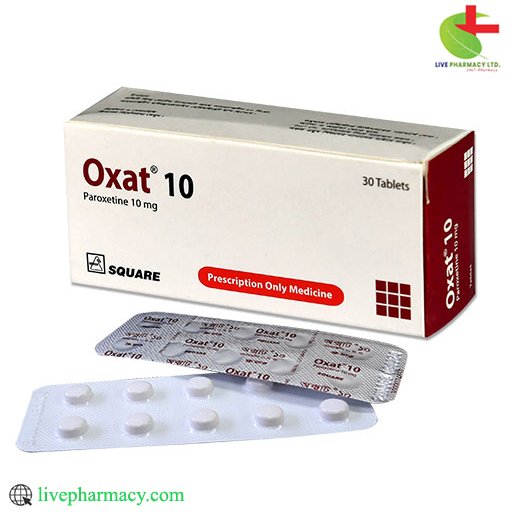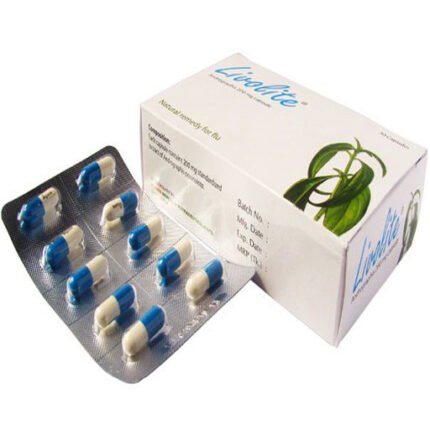Oxat 10
80.00৳ Strip
- Oxat is a trusted medication for Major Depressive Disorder, Obsessive Compulsive Disorder, Panic Disorder, Social Anxiety Disorder, Generalized Anxiety Disorder, and Posttraumatic Stress Disorder.
- Its potent pharmacology enhances serotonergic activity in the central nervous system for effective relief.
- Our dosage guidelines ensure personalized treatment, with incremental adjustments for optimal results.
- Comprehensive interaction and precautionary information prioritize patient safety.
- Trust us for reliable access to Oxat and expert guidance on its usage.
 Brand
Brand
|
Square Pharmaceuticals PLC |
|---|---|
 Generics
Generics
|
Paroxetine Hydrochloride |
Indications
Oxat serves as a treatment for various conditions, including Major Depressive Disorder, Obsessive Compulsive Disorder, Panic Disorder, Social Anxiety Disorder, Generalized Anxiety Disorder, and Posttraumatic Stress Disorder.
Pharmacology
The effectiveness of Paroxetine, the active ingredient in Oxat, is believed to be associated with the enhancement of serotonergic activity in the central nervous system. This enhancement results from the inhibition of neuronal reuptake of serotonin (5-hydroxy-tryptamine, 5 HT). Studies conducted at clinically relevant doses in humans have demonstrated that Paroxetine impedes the uptake of serotonin into human platelets. Additionally, in vitro studies conducted on animals suggest that Paroxetine acts as a potent and highly selective inhibitor of neuronal serotonin reuptake, with minimal effects on norepinephrine and dopamine neuronal reuptake. Paroxetine exhibits little affinity for various receptors, including muscarinic, alpha1, alpha2, beta adrenergic, dopamine (D2), 5-HT1, 5 HT2, and histamine (H1)-receptors. It’s important to note that the relative potencies of Paroxetine’s major metabolites are minimal compared to the parent compound.
Dosage & Administration
The recommended dosage for Oxat varies depending on the disorder being treated:
- Major Depressive Disorder: The initial dose is typically 20 mg/day, with possible increases up to 50 mg/day.
- Obsessive Compulsive Disorder: Patients are usually started on 20 mg/day, with potential increases up to 40 mg/day.
- Panic Disorder: The target dose is 40 mg/day, starting at 10 mg/day and increasing in 10 mg/day increments.
- Social Anxiety Disorder: The recommended initial dosage is 20 mg/day.
- Generalized Anxiety Disorder: The starting dose is typically 20 mg/day.
- Posttraumatic Stress Disorder: The initial dose is usually 20 mg/day, with potential increases in 10 mg/day increments.
Interaction
Oxat may interact with various substances, including tryptophan, certain drug metabolizing enzyme inducers/inhibitors, alcohol, haloperidol, amylobarbitone, oxazepam, MAOIs, lithium, phenytoin, anticonvulsants, and warfarin. It’s important to consult a healthcare professional regarding potential interactions.
Contraindications
Oxat should not be used concomitantly with monoamine oxidase inhibitors (MAOIs) or thioridazine. Additionally, individuals with a hypersensitivity to Paroxetine should avoid its use.
Side Effects
Common side effects associated with Oxat treatment include asthenia, sweating, nausea, decreased appetite, somnolence, dizziness, insomnia, tremor, nervousness, and various sexual disorders.
Pregnancy & Lactation
The use of Oxat during pregnancy should be carefully considered, weighing the potential benefits against the risks. Caution is advised when administering Oxat to nursing mothers.
Precautions & Warnings
Special precautions should be taken when treating patients with cardiac conditions, epilepsy, or seizures. Patients should be informed about potential effects on cognitive and psychomotor function, and discontinuation of Oxat treatment should be done gradually.
Use in Special Populations
For elderly patients, debilitated patients, and those with severe renal or hepatic impairment, the initial dose of Oxat is typically lower, starting at 10 mg/day.
Therapeutic Class
Oxat belongs to the class of selective serotonin reuptake inhibitors (SSRIs) and related antidepressant drugs.
Storage Conditions
Oxat should be stored in a cool, dry place, protected from light and moisture, and out of the reach of children.













Reviews
There are no reviews yet.